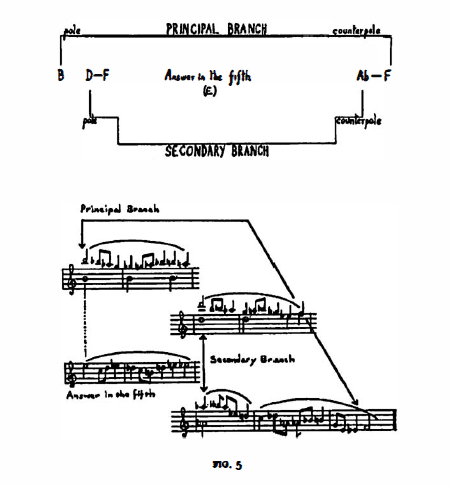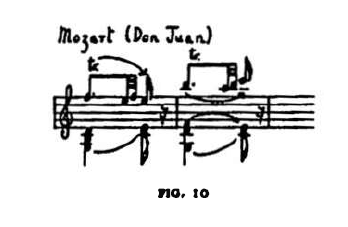- Béla Bartók: Analysis of his music 1.(sheet music available)
- Tonal Principles
- The Axis System
- Béla Bartók Piano Sonata, Sz. 80 with sheet music
Béla Bartók: Analysis of his music 1. (sheet music available)
Tonal Principles
The Axis System
“Every art has the right to strike its roots in the art of a previous. age; it not only has the right to but it must stem from it”, Bartok once declared.
His tonal system grew out of functional music. An uninterrupted line of evolution can be followed from the beginnings of functional . concepts, through the harmonies of Viennese classicism and the tone-world of romanticism to his axis system.
By an analysis of his compositions, this axis system can primarily be shown to possess the essential properties of classical harmony, i.e.
(a) the functional affinities of the fourth and fifth degrees
ibr the relationship ofrelative major and minor keys
(cd _the overtone relations
( d) the role ofleading notes
.ei the opposite tension of the dominant and subdominant (/) the duality of tonal and distance principles
(a)To begin with, let us try to situate Bartók’s tonal system in the circle of fifths, Let us take C as the tonic (T). Then F, the fourth degree, is the subdominant (S); G, the fifth degree, ia the dominant (D); A, the sixth degree and relative of the tonic, functions as a tonic; D, the second degree, and relative of the subdominant, functions as a subdominant; E, the third degree and relative of the dominant, functions as a dominant. The series of fifths, F-C-G-D-A-E corresponds to the functional series S-T-D-S-T-D.

We note that the sequence S-T-D repeats itself. When this periodicity is extended over the entire circle of fifths the scheme of the axis system may be clearly seen:

Let us separate the three funtions and call them tonic, subdominant dominant and dominant axes, respectively.


This table teaches yet another lesson. All four movements rest on the tonic axis, A-C-Eb-F#. Thus the first and fourth movements are supported by the “principal branch”, A and Eb,; the middle movements, however, by the “secondary branch”, C and F#, Thus each axis has a two-fold affinity depending on whether we oppose the pole with the counterpole, or the principal branch with the secondary branch.

Consequently the components of the axis system are as follows:

The Slow Movement of the Sonata for Two Pianos and Percussion is based on the subdominant axis, B-D-F-Ab, complying with the traditions of classical composition. The modal arrangement of its principal theme is symmetrical: the beginning and end supported by the B and F counterpoles (i.e. the principal branch of the axis).

b) A survey of the evolution of harmonic thinking leads to the
conclusion that the birth of the axis system was a historical
necessity, representing the logical continuation (and in a _<:ertain sense the completion) of European functional music. It can be demonstrated that the axis system, with its characteristic features had, in effect, been used by the Viennese “Greats”. Indeed, it had been recognised by Bach, in his chromaticism.
The sense of functional correlation in music was introduced in practice by the realisation of the I-IV-V-I affinity (in medieval modal music, at first in cadence form only) In the case of the C tonic:

The classical theory of harmony already speaks of primary and secondary triads inasmuch as the C may be replaced by its relative A, the F by its relative D and the G by its relative E.

Romantic harmony goes still further, making frequent use of the upper relatives. (Naturally only major and minor keys of similar key signature may be regarded as relatives, e.g. C major and A minor, or C minor and Eb major):

One more step completes the system. The axes extend the application of relatives to the whole system. The axis system implies the recognition of the fact that the common relative for A and Eb, is not only C, but also F# ( =Gb); that D and Ab, not only have F as a common relative, but also B; and that E and Bb, not only have G, but also C# ( =Db) as common relatives.

As is well known, Bartók showed a preference for the use ofso-called majoMninor chords (see Fig. 32b). For instance, its form in C tonality is:

The function remains unchanged even if the C major modeas shown in the above chord-is replaced by the relative A minor, or when the Eb major tonality replaces the relative C minor. This technique occurs regularly in Bartók’s music:

These substitute chords may also be employed in major-minor form, which brings the system to a close, since the relative of A major (F# minor) and that, of Eb, minor (Gb major) meet at a point of enharmonic co.incidence, F#=Gb.

These relatives, applied to dominant and subdominant harmony, again result in the scheme of the axis system.
(c) The theory of the axis system is also substantiated by the laws of acoustics. Acoustically, arriving from the dominant to the tonic, is to reach the root from an overtone-all cadential relations rest on the principle of interconnection between roots and their overtones. Thus, the dominant of C is not only G but also the next overtones E and Bb. Therefore the circle of tonic-dominant relationships is expanded to include E-C and Bb-C.
Since the D-T relationship corresponds relatively to
the T-S and
the S-D relationship,
overtone-root attraction exists between the T-S and the S-D, as well.

If we add the role of the nearest overtone, i.e. the fifth, then we
can deduce the complete axis system from these relations.
(d) In the simplest cadence, that of V7-I, the main role is played by the so-called sensitive notes which produce the pull of the dominant towards the tonic. The leading note pulls to the root and the seventh towards the third degree of the tonic, i.e. the leading note B resolves on C ind the seventh F on E or Eb.

These important sensitive notes bear a tritonic relationship to each other. The tritone–half the octave interval-is characterised by the interchangeability of its notes without changing the interval. Thus, if the B-F relationship is converted into an F-B one (as is frequently the case with Bartók), then the F ( =E#) assumes the role of the leading note, pulling towards the F# instead of E, while the seventh B pulls towards A# or A instead of C. So, instead of the expected tonic C major, the counterpole, the equally tonic F# major (or minor) emerges.

This resolution is reserved by Bartók for a sudden change of scene. The circumstances of an expected G7-C cadence emerging as G7-F# gives us a “Bartokean pseudo-cadence”.
(e) Starting from the tonic centre C we reach the dominant in one direction and the subdominant in the other, in identical latitudes. At a distance of i fifth we find the dominant G upwards and the subdominant F downwards. Regarding overtone relations we also get the dominant G, E, Bb, in the upper and the subdominant F, Ab, D the lower directions.

But what happens if the pendulum covers the latitude of a tritone? In this case the deviations made upwards and downwards meet, both ending at F# ( =Gb), and ifwe were to take one as the dominant, then the other would have to assume the subdominant function. By this coincidence, however, a neutralisation of their functions takes place, dominant and subdominan t merging are rendered ineffective in the interaction of their opposite forces.
Consequently the balance is saved, and the function is invariably that of the tonic. The counterpole is born. Similarly the distance between the tonic C and F# is bisected by Eb ( =D#) in the one and by A in the other direction; so lying in tensionless, neutral section points, they also have to be interpreted as tonics,. No more than four tonic poles can be surmised, since the intervals C-Eb, Eb-F#, F#-A, A-C provide no further points of bisection.
Finally, what significance should be attached to a swing of a chromatic degree, of C-B and its counterpart C-C# (=Db,)? Which is then to assume the dominant and which the subdominant function? Related to B, C# shows a degree of elevation of two fifths, which might correspond to the S-D interdependence, but not to its opposite. Anyway, the subdominant function of B and the dominant function of C# are unquestionable when they are related to the tonic F# counterpole.
(f) Thus, observing the logic of functional interconnection of the three axes, another interesting point arises. The subdominant and dominant are represented most effectively not by the degrees IV and V but, in the case of C tonality, the subdominant by Ab, (and its counterpole), the dominant by E (and its counterpole).
This is, after all, nothing new since there is, for instance, the dominant secondary theme in E of Beethoven’s Waldstein Sonata (C major) or the subdominant Slow Movement in Ab, of the Pathetique (C minor). The movements of Brahms’ First Symphony have the following key-sequence: C-E-Ab,-C in the sense of tonic-dominant-subdominant-tonic, etc.
However, the above examination of the axis system fails to explain why Bartók prefers these augmented triad relations to the traditional I-IV-V-I.
This necessitates a new approach to the system.
It is generally accepted that twelve-tone music shows a strong tendency to indifferent tonal relations.
Atonal relations can be most suitably effected by the equal division of the octave, or of the circle of fifths. By dividing the octave m twelve equal parts we get the chromatic scale; in the case of six equal parts we have the whole-tone scale; four equal parts gives us the chord of the diminished seventh; three the augmented triad, and finally by dividing the octave into two equal parts we arrive at the tritone.
For the present we shall exclude the whole-tone scale because of its limited possibilities: two whole-tone scales produce the chromatic scale by interlocking.
Every tonal system presupposes a centre as well as subordinate relations dependent on the centre. Taking again C as the tonic centre, the three functions are represented most potently by those degrees dividing the circle of fifths into three equal parts, i.e. in the augmented triad C-E-Ab. Properties inherent in classical harmony are responsible for the E assuming a dominant function and Ab, a subdominant function in relation to the tonic C.
Each of these main notes permit their substitution by their counterpoles, i.e. their tritonic equivalents. Thus, C may be replaced by F#, E by Bb, and Ab by D.
If we divide the twelve-tone chromatic scale proportionally between the three functions, each function will have four poles, and these-insofar as we keep to the distance principle-are arranged in diminished-seventh relations, dividing the circle into four equal parts. Accordingly, C-Eb-F#-A belong to the range of the C tonic, E-G-Bb-C# to that of the dominant E main note, and Ab-B-D-F to that of the subdominant Ab, main note.
So, the tonal system resulting from a division of the chromatic scale into equal parts agrees completely with the axis system:

Put concisely, given the twelve-tone system and the three functions this is the on[y system that can be realised by means of distance division.
Viewed historically, the axis system reflects the age-old struggle between the principles-of tonaliry and equi-distance, with the gradual ascendancy of the latter which finally resulted in the free and equal treatment of the chromatic twelve notes.
Here we have to draw a line between Bartók’s twelve-tone system and the Zwölftonmusik of Schönberg. Schönberg annihilates and dissolves tonality whereas Bartók incorporates the principles of harmonic thinking in a perfect synthesis. To penetrate into Bartók’s creative genius is to discover the natural affinities and intrinsic possibilities, inherent in the musical material.
Béla Bartók Piano Sonata, Sz. 80 with sheet music
Browse in the Library:
| Artist or Composer / Score name | Cover | List of Contents |
|---|---|---|
| Timbaland – Way I Are | ||
| Time (Inception) – Hans Zimmer – Solo Piano (Musescore File).mscz | ||
| Time is like a dream (Interlude OST) Georges Delerue | ||
| Time Travel Theme – Secret (Jay Chou) |
 |
|
| Timothy Brown – Daydreaming |
 |
|
| Timothy Brown – Lyric Expressions Solo Piano |
 |
|
| Timothy Brown – Soliloquy |
 |
|
| Tina Arena – Burn | ||
| Tina Turner – I, Tina (Book) |
 |
|
| Tina Turner – The Best Of Simply The Best Piano Vocal guitar Chords |
 |
Tina Turner – The Best Of Simply The Best Piano Vocal guitar Chords – –  |
| Tina Turner – What’s Love Got To Do With It | Tina Turner – What’s Love Got To Do With It | |
| Tina Turner – What’s Love Got To Do With It.mscz | ||
| Tina Turner Goldeneye (James Bond frilm Theme) |
 |
|
| Titanic – My Heart Will Go On (James Horner) |
 |
|
| Titanic – James Horner Full songbook |
 |
Titanic – James Horner |
| Titanic Movie Theme – My Heart Will Go On – Piano Guitar Vocals | Titanic Movie Theme – My HeArt Will Go On – Piano Guitar Vocals | |
| To Be Pleasing You Jazz Piano Solo arr. sheet music |
 |
|
| To love you more (Celine Dion) | ||
| To Zanarkand Final Fantasy X |
 |
|
| To Zanarkand (Final Fantasy X) (Musescore File).mscz | ||
| TOCH, E. – La Melodía(Spanish) 1923 |
 |
|
| Tom Jobim Girl from Ipanema | Tom Jobim girl from ipanema | |
| Tom Jobim Agua de Beber | Tom Jobim Sheet Music – Agua de Beber | |
| Tom Jobim Desafinado | ||
| Tom Jobim Ligia | ||
| Tom Jobim Samba Verao | ||
| Tom Jobim songbook 1 Guitar (by Almir Chediak) |
 |
Tom Jobim songbook I (Guitar) |
| Tom Jobim songbook 2 Guitar (by Almir Chediak) |
 |
Tom Jobim songbook I (Guitar) |
| Tom Jobim songbook 3 Guitar (by Almir Chediak) |
 |
Tom Jobim songbook I (Guitar) |
| Tom Jobim Triste | ||
| Tom Jobim Vivo Sonhando | ||
| Tom Jones Greatest Hits |
 |
Tom Jones Greatest Hits |
| Tom Kolb – Chord Progressions for Guitar (with audio MP3) |
 |
Tom Kolb – Chord Progressions for Guitar (with audio MP3) |
| Tom Odell Another Love |
 |
|
| Tom Petty Anthology Guitar Anthology Series with TABs |
 |
Anthology Tom Petty Guitar |
| Tom Petty Sheet Music Anthology – Tom Petty |
 |
Tom Petty Sheet Music Anthology – Tom Petty |
| Tom Petty, Best of (Songbook), The – Tom Petty sheet music |
 |
Tom Petty, Best of (Songbook), The – Tom Petty sheet music |
| Tom Turpin The Harlem Rag | Tom Turpin Harlem-Rag | |
| Tom Waits -Alice (entire album songbook) Piano-vocal-guitar |
 |
Tom Waits -Alice (entire album songbook) Piano-vocal-guitar |
| Tom Waits Anthology 29 Titres |
 |
Tom Waits Anthology |
| Tom Waits Beautiful Maladies |
 |
Tom Waits Beautiful Maladies |
| Tom Waits Blood Money |
 |
Tom Waits Blood Money |
| Tommy Emmanuel The Mystery Transcriptions Mel Bay Presents Guitar TAB |
 |
Tommy Emmanuel The Mystery Transcriptions Mel Bay Presents Guitar TAB |
| Tommy Flanagan – Moritat Mack The Knife Solo transcription | Tommy Flanagan – Moritat Mack The Knife Solo transcription | |
| Tommy Flanagan Wee Dot sheet music transcription |
 |
|
| Tommy Flint – Best Of Country Guitar Solos with audio MP3 with TABs |
 |
Tommy Flint – Best Of Country Guitar Solos with audo content |
| Tommy Shaw – Boat On The River from Styx |
 |
|
| Tomorrow (Europe) | ||
| Tomorrow (From Annie) Sheet Music – Charles Strouse |
 |
|
| Tomorrowland Music From The Motion Picture Soundtrack Piano Solo by Michael Giacchini |
 |
Tomorrowland Music From The Motion Picture Soundtrack Piano Solo by Michael Giacchini |
| Tomoya Naka Rainy Song | Tomoya | |
| Tonari no Totoro – My Neighbor Totoro (Joe Hisaishi) |
 |
|
| Toni Braxton – Unbreak My Heart | ||
| Tonight from West Side Story (Leonard Bernstein) Easy Piano Solo arr. sheet music | Tonight from West Side Story (Leonard Bernstein) Easy Piano Solo arr. sheet music | |
| Tonight From West Side Story (Leonard Bernstein) Easy Piano Solo Arr. Sheet Music (Musescore File).mscz | ||
| Tony Alonso Mass Of Joy And Peace For Sab Voices And Accompaniement |
 |
|
| Tony Bennett Life Is a Gift The Zen of Tony Bennett (Book) |
 |
|
| Top 10 22 Pop Hits Piano Vocal Guitar Chords |
 |
Top 10 22 Pop Hits Piano Vocal Guitar Chords |
| Top 10 Classical Favorites |
 |
Top 10 Classical Favorites |
| Top Christian Hits Of 2019 2020 Piano Vocal Guitar 20 Powerful Songs |
 |
Top Christian Hits Of 2019 2020 Piano Vocal Guitar 20 Powerful Songs |
| Top Hits For Piano Solo 20 Great Songs |
 |
Top Hits For Piano Solo 20 Great Songs |
| Top Hits Of 2011 |
 |
TOP HITS 2011 |
| Top Hits Of 2013 |
 |
Top Hits Of 2013 |
| Top Hits Of 2017 Sheet Music 18 great songs Piano Vocal Guitar |
 |
Top Hits Of 2017 Sheet Music 18 great songs Piano Vocal Guitar |
| Top Hits of 2018 Songbook – sheet music |
 |
Top Hits of 2018 Songbook – sheet music |
| Top Movie Hits SongBook |
 |
Top Movie Hits SongBook |
| Top Rock Volume 2 (Guitar) |
 |
Top Rock songbook guitar |
| TOP TEN – N°1 |
 |
TOP TEN – N°1 |
| Top Ten – N°2 |
 |
Top Ten – N°2 |
| Top Ten 40 (Guitar) |
 |
Top ten 40 guitar songbook |
| Top Ten 43 (Guitar) |
 |
Topp ten 43 guitar songbook |
| Top Ten Slow (Guitar) |
 |
Top Ten Slow (Guitar) |
| TOP TEN X3 (5) Guitar piano |
 |
TOP TEN X3 (5) Guitar piano |
| Toquinho – A Arte Brasilera de – sheet music songbook Guitar Tabs |
 |
Toquinho – A Arte Brasilera de – sheet music sogbook Guitar Tabs |
| Toquinho – Aquarela Guitar with TABs |
 |
|
| Tori Amos – Silent All These Years | ||
| Tori Kelly Paper Hearts Piano |
 |
|
| Torna A Surriento Traditional Neapolitan Song By Ernesto De Curtis (Easy Piano Solo With Lyrics In English) |
 |
|
| Torna a Surriento.mscz | ||
| Toshifumi Hinata End Title (Tokyo Love Story) |
 |
|
| Toshihiko Sahashi Fuuki Iinchou Hibari Kyoya | Toshihiko Sahashi Fuuki Iinchou Hibari Kyoya | |
| Toshihiko Sahashi Katekyo Hitman Reborn Hibari Kyoyas Theme | Toshihiko Sahashi Katekyo Hitman Reborn Hibari Kyoyas Theme | |
| Toshihiko Sahashi Tsuna Awakens Ost Katekyo Hitman Reborn |
 Toshihiko Sahashi Tsuna Awakens Ost Katekyo Hitman Reborn
Toshihiko Sahashi Tsuna Awakens Ost Katekyo Hitman Reborn |
|
| Total Guitar – The ultimate scale book |
 |
|
| Toto Guitar Anthology Authentic Guitar Tab |
 |
Toto Guitar Anthology Authentic |
| Toto – Africa (Easy Piano Solo Arr. Sheet Music) | Toto – Africa (Easy Piano Solo Arr. Sheet Music) | |
| Toto – Africa (Intermediate Piano Solo arr.) | Toto – Africa | |
| Toto – Childs Anthem (Intermediare Piano Solo arr.) | Toto – Childs Anthem (Intermediate Piano Solo arr) | |
| Toto – The Best Of Toto (Guitar, Kbds, Bass, Drum, Vocal) | Toto – The Best Of Toto (Guitar, Kbds, Bass, Drum, Vocal) | |
| Tournemire op. 33 Po me Mystique | ||
| TOY STORY – Randy Newman – You’ve Got A Friend In Me |
 |
|
| Toy Story – When She Loved Me – Sarah Mclachlan | ||
| Toy Story Easy Piano Collection (Songbook) 8 Songs From The Popular Movies |
 |
Toy Story Easy Piano Collection (Songbook) 8 Songs From The Popular Movies |
| Tracy Chapman – Complete Songbook |
 |
Tracy Chapman – Complete Songbook |
| Tracy Chapman – Tracy Chapman music songbook |
 |
Tracy Chapman – Tracy Chapman music songbook |
| Tracy Chapman Fast Car Sheet Music |
 |
|
| Traditional – Swing Low Sweet Charriot | Traditional – Swing Low Sweet Charriot | |
| Traditional Dona Nobis Pacem (Piano Solo Arr.) Give Us Peace Musescore File.mscz | ||
| Traditional English Carol – The First Noel | Traditional English Carol – The First Noel | |
| Traditional English Carol The First Noël (Piano Solo).mscz | ||
| Trailer Park The Musical Piano Vocal Score by David Nehls and Betsy Kelso |
 |
|
| Train – Drops Of Jupiter | ||
| Transparent Theme (Solo Piano) (Musescore File).mscz | ||
| Tratado de Armonia – Arnold Schoenberg (Spanish-Español) | Book Theory | |
| Travelin Soldier – Dixie Chicks | ||
| Trepat , Carles – Homenaje A Baden Powel |
 |
|
| Trepat, Carles Nana De Sevilla Partitura (Guitar, Guitarra) |
 |
|
| Trinity – Pop and Rock Guitar Grade 1 Contemporary & Classic songs with TABs |
 |
Trinity – Pop and Rock Guitar Grade 1 Contemporary & Classic songs |
| Trinity – Pop and Rock Guitar Grade 2 Contemporary & Classic songs with TABs |
 |
Trinity – Pop and Rock Guitar Grade 2 Contemporary & Classic songs |
| Trinity – Pop and Rock Guitar Grade 3 Contemporary & Classic songs with TABs |
 |
Trinity – Pop and Rock Guitar Grade 3 Contemporary & Classic songs |
| Trinity – Pop and Rock Guitar Grade 4 Contemporary & Classic songs with TABs |
 |
Trinity – Pop and Rock Guitar Grade 4 Contemporary & Classic songs |
| Trinity 2010-2015 Guitar Grade 3 Pieces & Exercises |
 |
|
| Trinity Classical Guitar 2010-2015 Grade 07 |
 |
|
| Trinity Classical Guitar 2020-2023 Grade 01 |
 |
|
| Trinity Classical Guitar 2020-2023 Grade 02 |
 |
|
| Trinity Classical Guitar 2020-2023 Grade 03 |
 |
|
| Trinity Classical Guitar 2020-2023 Grade 04 |
 |
|
| Trinity Classical Guitar 2020-2023 Grade 05 |
 |
|
| Trinity Classical Guitar 2020-2023 Grade 06 |
 |
|
| Trinity Classical Guitar 2020-2023 Grade 08 |
 |
